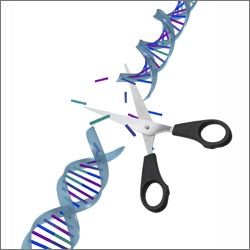
Over the last two decades, exciting tools have emerged that allow researchers to cut and paste specific sequences of DNA within living cells, a process called gene editing. These tools, including one adapted from a bacterial defense system called CRISPR, have energized the research community with the possibility of using them to modify human genes associated with disease.
A major barrier to testing medical applications of gene editing has been getting the proteins that do the cutting into the cells of living animals. The main methods used in the laboratory take a roundabout route: Researchers push the DNA templates for making the proteins into cells, and then the cells’ own protein factories produce the editing proteins.
Researchers led by David Liu ![]() from Harvard University are trying to cut out the middleman, so to speak, by ferrying the editing proteins, not the DNA instructions, directly into cells. In a proof-of-concept study, their system successfully delivered three different types of editing proteins into cells in the inner ears of live mice.
from Harvard University are trying to cut out the middleman, so to speak, by ferrying the editing proteins, not the DNA instructions, directly into cells. In a proof-of-concept study, their system successfully delivered three different types of editing proteins into cells in the inner ears of live mice.
The team accomplished this by first attaching the editing proteins to other, negatively-charged proteins, and then wrapping these pairs in a positively-charged fatty coating. The negative and positive charges make the proteins and wrapper cling together like magnets to a refrigerator.
When the positively-charged coating bumps into naturally negatively-charged proteins on the surface of a cell, it sticks. The cell draws the coated proteins inside, where the coating disintegrates and leaves the editing proteins in the cell’s interior.
In their mouse ear cell experiments, the researchers found the accuracy of gene editing was much higher with direct protein delivery than compared to DNA delivery. Liu explained that the delivered proteins break down in cells before they have a chance to modify off-target DNA sequences, unlike when gene-editing proteins are made from delivered DNA.
As Liu said in a news release about this work ![]() , “We hope this approach to protein delivery will help connect where genome editing is now to where the field needs to be in order to realize the therapeutic potential of these proteins to address genetic diseases.”
, “We hope this approach to protein delivery will help connect where genome editing is now to where the field needs to be in order to realize the therapeutic potential of these proteins to address genetic diseases.”
This work was funded in part by NIH under grants R01GM095501, DP1GM105378, R01DC006908 and F32GM106601.

